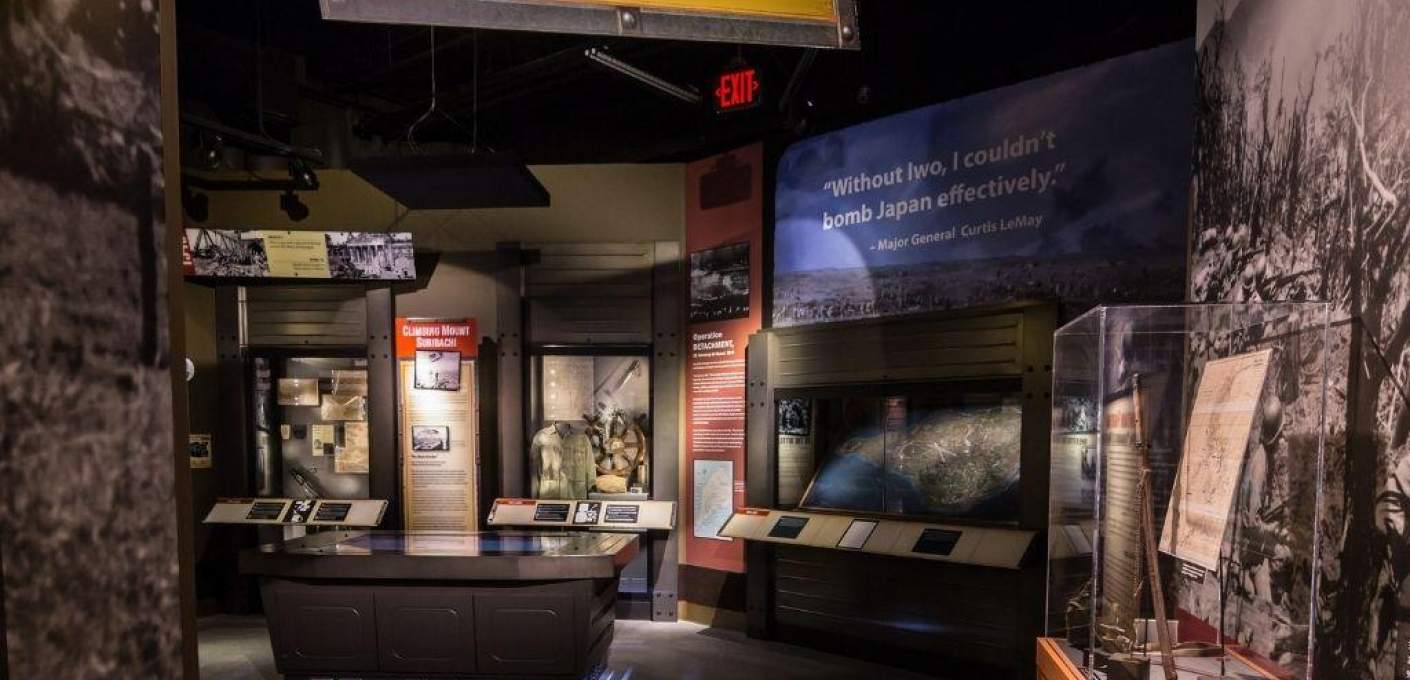
Permanent Exhibit
Iwo Jima Exhibit
This exhibit is a part of our permanent collection and can be seen with our General Admission tickets.
Overview
Beyond the story behind the iconic photo of the flag-raising on Mt. Suribachi, learn about the significance of capturing that volcanic mass and the unique challenges of the horrific 36-day battle. The exhibit includes an M2-2 flamethrower, a weapon instrumental in our Iwo Jima victory.
Operation DETACHMENT, the amphibious assault on the island of Iwo Jima, was conceived during a military strategic planning meeting in San Francisco in the fall of 1944. Eight square miles in size and located 750 miles from Tokyo, Iwo Jima is part of the Bonin Islands and was considered Japanese soil. The Allies needed to neutralize Iwo Jima because the Japanese had a radar station there, which provided early warning to the home islands of impending B-29 strikes originating from the Marianas. The Allies also sought to use Iwo Jima as a base for shorter range fighters to provide cover for bombers attacking the home islands.
Japan realized the importance of Iwo Jima and began fortifying the island in early 1944. Taking advantage of the rough terrain, they created a network of concealed emplacements for artillery, mortars, and machine guns that covered the island in interlocking fields of fire. The positions were interconnected by an intricate system of underground tunnels, excavated rooms, blockhouses, and caves. The island’s highest ground, Mount Suribachi, contained many of these defensive positions.
Beginning on 19 February 1945, about 60,000 Marines faced an estimated 21,000 Japanese troops. After four days of intense fighting, Marines raised an American flag atop Mount Suribachi. Joe Rosenthal, an AP photographer captured the iconic moment. The fighting continued, lasting into March. Eliminating Japanese pillboxes and underground emplacements proved slow and arduous. Marines deployed flame throwers, satchel charges, and hand grenades against an entrenched and determined enemy. Marines at times measured progress in yards.
Indispensable Navajo code talkers maintained secure communications during the battle. The Fifth Marine Division had six code talkers working around the clock during the first two days of the battle. Nine days into the battle, the Marines had gained 4,000 yards at the high cost of 7,000 casualties. General Tadamichi Kuribayashi, the Japanese garrison commander, committed suicide in his command post on 23 March. Three days later, Iwo Jima was declared secure on 26 March.
The Battle of Iwo Jima cost US forces 6,871 lives and 19,217 wounded. The fighting at Iwo Jima mirrored the savagery encountered later at Okinawa, and provided a glimpse of what to expect should an invasion of the Japanese home islands become necessary. Of the 22 Marines and five Sailors awarded Medals of Honor, 14 were awarded posthumously.
In the Iwo Jima exhibit at the museum, visitors will see a foam rubber relief map of Iwo Jima showing details of the terrain as well as an artist’s drawings of the defensive positions produced after the battle. Visitors will also see a flamethrower and a tabletop map summarizing the battle. Also, a 7th War Loan poster signed by three of the Mount Suribachi flag-raisers is on display.


